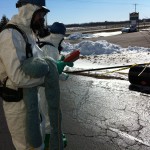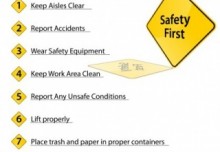 Understanding Chemical Properties to Manage Spill Response
Understanding Chemical Properties to Manage Spill Response
When responding to emergencies you must be aware that an emergency scene can involve the release of hazardous materials. Recognizing these scenarios may not be obvious. Identifying the occupancy and location such as industrial, commercial or transportation can help you begin your investigation as to the potential for a spill, what types of materials and quantities of materials may be involved.
The first step when responding to an emergency is to isolate the scene. You can use the Emergency Response Guidebook (ERG) for basic information including health and fire precautions and evacuation distances, but the ERG is not chemically specific. Once the scene has been isolated, the next step is to identify the product or products involved. Communication with property owners, law enforcement, transport personnel and eye witnesses can aid in identification.
If you cannot identify the chemical, OSHA and NFPA specify that you must treat the unknown spill as a Level B spill or higher. Higher would be Level A. For more information on OSHA Levels, click here.
Best practice for responders is to always carry a NOISH Pocket Guide. Once the chemical is known, the NOISH Pocket Guide along with the Safety Data Sheet, formerly MSDS, will help you understand and calculate density, flammability and solubility for the chemical.
Here are some ways to relate what you find in the NIOSH Pocket Guide and Safety Data Sheets with materials in which you are familiar.
By this point you will know whether the material is a solid, liquid or gas. You determine the state of matter to predict the path of exposure, establish monitoring and select the proper PPE. A solid that was spilled will stay where it was spilled however, weather factors such as wind and rain can effect the spread. Liquids tend to follow the contour of the land and take on the shape of its “container”. Gases want to disperse or mix with the air and will be effected by wind and/or air current. Gases are the most mobile state of matter.
When dealing with solids, chemical properties of solubility, bulk density and melting point will help determine if weather factors i.e. rain, wind or temperature will effect the spread. Water is known as the universal solvent. A chemical that is soluble in water will dissolve when exposed to rain. Sheltering the material from the rain will allow for isolation of the spill until the material can be removed. The bulk density of a product tells us how much a known volume of the product weighs, and is expressed in pounds per cubic feet (lb/cu.ft). For instance, a material such as wheat flour at 42 lb/cu.ft, is considered a low bulk density and will be easily spread by a light wind. A material such as sand at 99 lb/cu.ft would be considered a high bulk density and will not be as easily spread. The melting point is the temperature at which a solid will become a liquid. Those substances with low melting points may be solids in the winter, but liquids in the summer like ice becomes water.
For spills involving liquids, land contour will dictate where the material pools. Chemical properties like solubility, specific gravity, vapor pressure and pH will aid in determining how to mitigate the problem. Solubility, as expressed in percent (%), is the amount of the material that can be dissolved in water. Specific gravity, when compared to water where water is given the value of one, will determine if the material will sink or float with respect to water. A liquid with a specific gravity of less than one will float on water, such as gasoline. A liquid with a specific gravity of more than one will sink in water, such as corn syrup. Vapor pressure relates to how much vapor will be given off by the liquid from the surface. The larger the surface area of the spill, the greater the potential for vapors to be given off before the spill is mitigated. The pH of a liquid, which is a measure of how corrosive something is, determines whether the material is an acid or base. This is important to know prior to monitoring, since corrosive vapors can ruin sensitive electronic instruments.
When dealing with gases you will want to identify the vapor density and flammable range. The vapor density of gases are similar to the specific gravity of liquids, only the comparison is air. Gases with a vapor density greater than one will sink, whereas gases with a vapor density of less than one will rise, with respect to air. Flammable ranges are used to characterize the vapors given from a flammable liquid or a gas. The flammable range is defined as the difference between the upper and lower flammability limits. If the concentration is too lean to burn, it is below the lower explosive limit. If the concentration is too rich to burn, it is above the upper explosive limit.
The chemical characteristics of pH and flammability can be measured on scene with the appropriate instruments. Other properties such as vapor density, specific gravity and boiling point can be found in resource material such as the NIOSH Pocket Guide.
We hope these examples and ideas help you relate the information you gather and calculate when dealing with chemical spills and the knowledge helps you make informed decisions as to initial isolation and personal protection.












